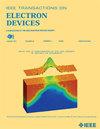Low-Frequency Noise Characterization of BEOL Metal–Insulator–Metal Capacitors
IF 2.9
2区 工程技术
Q2 ENGINEERING, ELECTRICAL & ELECTRONIC
引用次数: 0
Abstract
Dielectrics are fundamental building blocks in both analog and digital electronic devices, serving various purposes, including insulating metal lines and interconnect levels in the back-end-of-line (BEOL). In this article, we investigate the leakage and low-frequency noise (LFN) properties of three different types of dielectrics, from the low-k organo-silicate glass (OSG3.0) and silica (SiO2) to the high-k alumina (Al2O3). Test structures are large area (up toBEOL金属-绝缘子-金属电容器的低频噪声特性
电介质是模拟和数字电子设备的基本组成部分,用于各种用途,包括绝缘金属线路和后端线路(BEOL)的互连水平。在本文中,我们研究了三种不同类型的电介质,从低钾有机硅酸盐玻璃(OSG3.0)和二氧化硅(SiO2)到高钾氧化铝(Al2O3)的泄漏和低频噪声(LFN)特性。测试结构是大面积(高达$200\times 200~\mu $ m2)金属-绝缘体-金属(MIM)电容器,带有TiN或TaNTa电极,可以很好地模拟BEOL结构。特别是,据我们所知,没有关于osg的LFN研究报道,osg是BEOL中最常用的一类介电体。从物理方面来看,电流-电压(I-V)表征表明,在所有三种介质中,传导都是由陷阱主导和辅助的,而不是由电极注入限制的。LFN测量(LFNMs)显示所有三种介质具有强偏置依赖性门噪声参数$(\text {GNP})\propto {S}_{I}/{I}^{{2}}$ (I为直流电流)的典型1/f电流功率谱密度(PSD) (${S}_{I}$),表明能量阱分布高度不均匀,特别是对于Al2O3器件。基于sio2的电容器在等效场下表现出最低的泄漏,在相当的泄漏电流下表现出优越的噪声性能。Al2O3器件表现出最高的泄漏,而OSG3.0样品表现出最差的噪声特性,其特征是明显的电不稳定性和非平稳随机电报信号(RTS)事件。
本文章由计算机程序翻译,如有差异,请以英文原文为准。
求助全文
约1分钟内获得全文
求助全文
来源期刊

IEEE Transactions on Electron Devices
工程技术-工程:电子与电气
CiteScore
5.80
自引率
16.10%
发文量
937
审稿时长
3.8 months
期刊介绍:
IEEE Transactions on Electron Devices publishes original and significant contributions relating to the theory, modeling, design, performance and reliability of electron and ion integrated circuit devices and interconnects, involving insulators, metals, organic materials, micro-plasmas, semiconductors, quantum-effect structures, vacuum devices, and emerging materials with applications in bioelectronics, biomedical electronics, computation, communications, displays, microelectromechanics, imaging, micro-actuators, nanoelectronics, optoelectronics, photovoltaics, power ICs and micro-sensors. Tutorial and review papers on these subjects are also published and occasional special issues appear to present a collection of papers which treat particular areas in more depth and breadth.
 求助内容:
求助内容: 应助结果提醒方式:
应助结果提醒方式:


